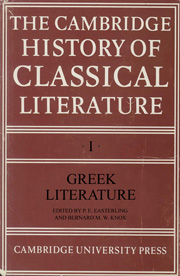Book contents
- Frontmatter
- 1 Books and readers in the Greek world
- 2 Homer
- 3 Hesiod
- 4 The epic tradition after Homer and Hesiod
- 5 Elegy and iambus
- 6 Archaic choral lyric
- 7 Monody
- 8 Choral lyric in the fifth century
- 9 Early Greek philosophy
- 10 Tragedy
- 11 The satyr play
- 12 Comedy
- 13 Historiography
- 14 Sophists and physicians of the Greek enlightenment
- 15 Plato and the Socratic work of Xenophon
- 16 Oratory
- 17 Aristotle
- 18 Hellenistic poetry
- 19 Post-Aristotelian philosophy
- 20 The literature of the Empire
- 21 Epilogue
- Appendix of authors and works
- Metrical appendix
- Works Cited in the Text
- References
6 - Archaic choral lyric
Published online by Cambridge University Press: 28 March 2008
- Frontmatter
- 1 Books and readers in the Greek world
- 2 Homer
- 3 Hesiod
- 4 The epic tradition after Homer and Hesiod
- 5 Elegy and iambus
- 6 Archaic choral lyric
- 7 Monody
- 8 Choral lyric in the fifth century
- 9 Early Greek philosophy
- 10 Tragedy
- 11 The satyr play
- 12 Comedy
- 13 Historiography
- 14 Sophists and physicians of the Greek enlightenment
- 15 Plato and the Socratic work of Xenophon
- 16 Oratory
- 17 Aristotle
- 18 Hellenistic poetry
- 19 Post-Aristotelian philosophy
- 20 The literature of the Empire
- 21 Epilogue
- Appendix of authors and works
- Metrical appendix
- Works Cited in the Text
- References
Summary
THE NATURE OF EARLY CHORAL POETRY
From Alcman in the seventh century to Timotheus at the beginning of the fourth, choral lyric remains an important literary form. Performed by citizen choruses — men, boys, women, or girls — as well as by guilds of professionals, these poems were sung by a dancing chorus at public religious festivals or at important family events like weddings or funerals. Because the festivals in honour of the gods also celebrated the civic life of the polis, choral song played a major role in affirming the values and solidarity of the community. The connexion between music and ethical values, in fact, remains strong through the archaic and classical periods. Like much of early Greek poetry, choral lyric is public rather than personal in outlook, expression and orientation. In this respect it differs from monodic lyric, which is much more an expression of personal emotion.
The basic forms and sub-genres of choral lyric are already attested in Homer and doubtless reach back long before the literary evidence. The Shield of Achilles in the Iliad describes a marriage song (hymenaios, II. 18.491–6), a harvest song accompanied by dancing (18.569–72), and an elaborate performance of dance and song by youths and maidens at Cnossus (18.590–606). In the Odyssey the bard Demodocus sings the famous song about the illicit love of Ares and Aphrodite while all around him the young Phaeacians dance to its rhythm (8.262ff.). These passages imply a close interconnexion of music, dance and poetry in choral lyric.
- Type
- Chapter
- Information
- The Cambridge History of Classical Literature , pp. 165 - 201Publisher: Cambridge University PressPrint publication year: 1985
References
- 1
- Cited by

